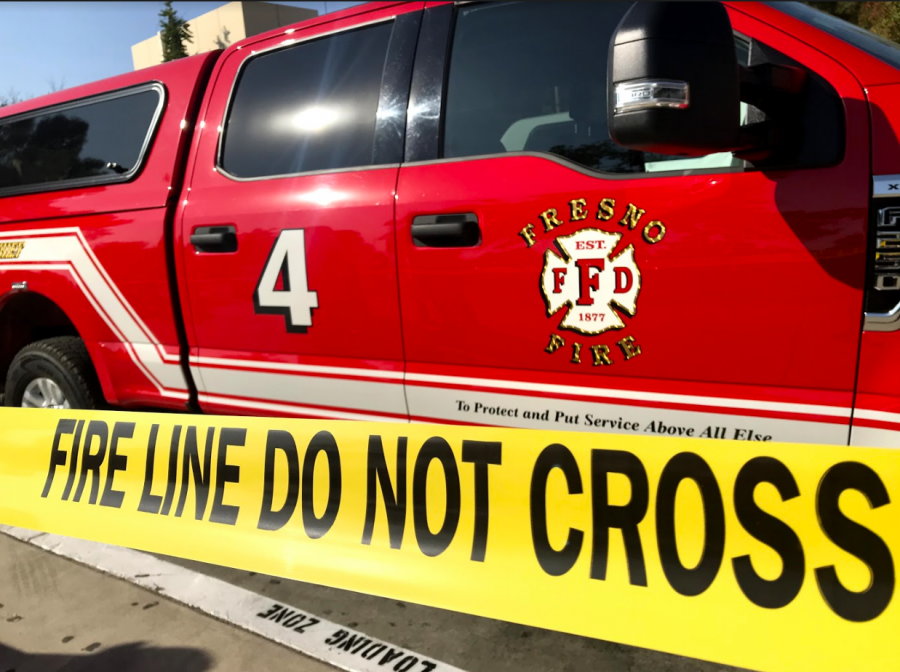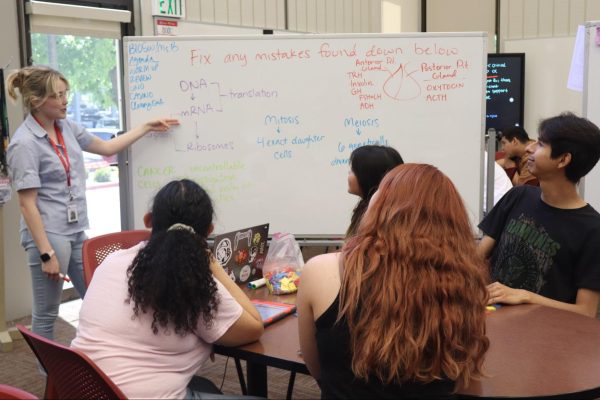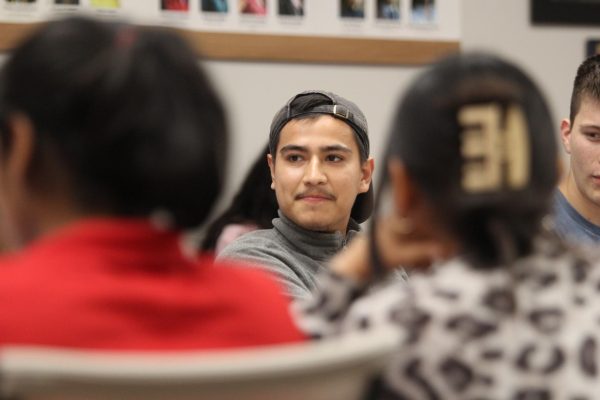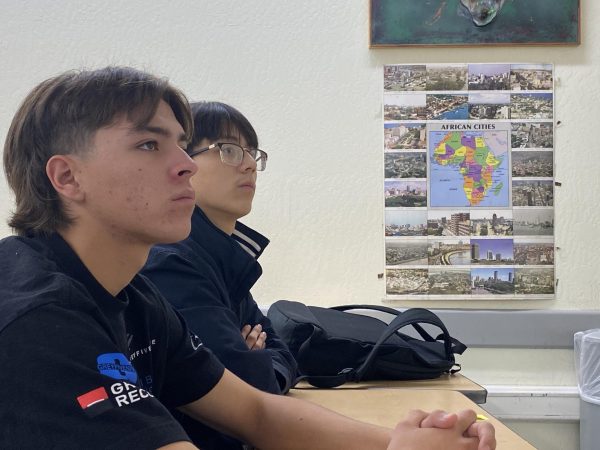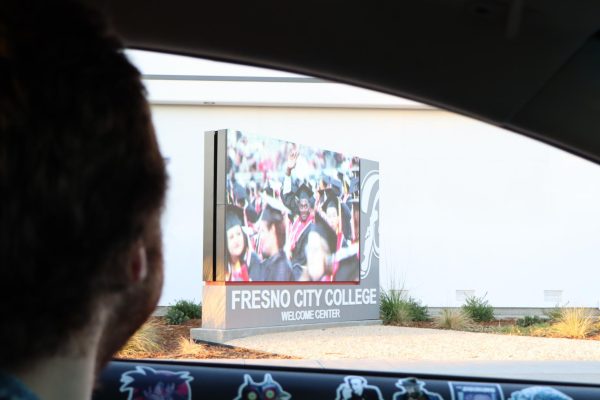Questions Persist After Chemical Spill Hospitalizes 4
Photo by: Mark Ross
The fire department was called to evacuate the MSE building after a chemical spill. Four students were hospitalized.
Hawkins Dowis was administering a quiz between 8 a.m. and 9 a.m. on Thursday, Oct. 10 when the ceiling of his biology classroom, S-120 of the Math, Science and Engineering building began to leak.
“I had the students move and placed a couple trash cans underneath the leak to catch the water,” Dowis said.
Then he alerted technicians who alerted maintenance.
“The maintenance guy showed up soon after and was pretty startled,” Dowis said.
Maintenance left.
A campus police officer arrived.
And then the entire MSE building was evacuated and classes were canceled for the rest of the day.
Before the leak, in the floor above Dowis’ biology classroom, the students in Karin Gruet’s chemistry class were taking their midterm exam when a student accidentally spilled a chemical that they were working with.
The chemical contents, not known by the students at the time, was a diluted form of NaOH, or sodium hydroxide.
The goal of the midterm was to identify the unknown chemical.
Early on in the exercise a student dropped the beaker with the chemical which then shattered on the lab table.
On the day of the incident, it was initially reported as an acid spill, but it was not an acid spill at all. “It was a weak base,” said Shirley McManus, dean of instruction of Math, Science and Engineering.
Gruet, who was the only person in the lab who knew the contents of the chemicals that the students were working with, was assisting students on the other side of the classroom when the spill occurred.
She was unable to determine which of the four chemicals had splashed on the students.
McManus said the students were all part of a chemical identification lab where, of the seven chemicals present in the lab, students were working with four of them.
“Of the students in the room, none of the victims were at all responsible for what happened,” McManus said.
At first, there seemed to be only three students Eunice Odozie, Cassandra Rangel and one other victim who does not wish to be identified, to have the chemical on them.
As is proper procedure with a chemical spill of any kind, they were all ushered to the safety shower immediately to rinse off.
“I don’t have a full grasp of what happened. I know there was a splash,” said Odozie after having her face exposed to the chemical.
Missing from the shower was victim Elinore Alms. Her exposure to the chemical was localized only to her hand, so she left her hand under the sink while the other three victims went under the shower.
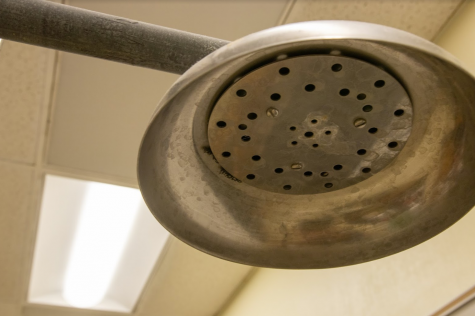
The emergency shower flooded after it was employed to decontaminate three students on the second floor for the required five minutes. The water seeped down into the classroom on the first floor.
The Chemical Spill
“It started pretty normal [the midterm],” Alms said. “It was a pretty mundane day.”
But then, the accident occured.
Alms said that the girl who spilled the chemical was from a different lab and was only trying to finish her midterm.
Early on in the exam, one of the pipettes—a glass rod used in chemistry to administer small droplets of liquid—broke. “And then a few minutes later, another one broke,” she said.
According to Alms, Gruet told the class, “‘Alright guys let’s calm down. We don’t have enough equipment, so please don’t break any more.’”
The next thing to break was the beaker full of sodium hydroxide. Students at the scene described the instance as a pop, but Alms clarified, “the sound was the glass breaking.”
“My first thought was something came and hit my finger,” Alms said. “This being the third piece of glass that broke that day, I thought it was glass.”
“There was a news company who talked to me that day who said in their report that I screamed because it burned,” she joked. “I didn’t even think it was a burn at first. I thought it was glass.”
But when she looked down at her hand, instead of seeing blood, she saw something that worried her more. NaOH, like many chemicals, appears clear like water. That was what Alms saw on her hand — a substance that looked like water, but burned.
McManus explained that everything from the moment of the spill happened very quickly. The beaker was dropped onto the lab table, about waist level to the students.
The student who dropped the beaker was unavailable for a comment. All that can be confirmed is that the student left the area almost immediately, and did not appear to be hurt by broken glass or exposure to the spilled chemical.
Alms said she was initially in recovery mode and her first mission was to get herself clean. She used a sink in the lab to wash her hand, one of the best things to do in the event of an unknown chemical spill, according to Alms.
She noticed that three girls were huddled around another sink across the room.
“The other girls, they got it on their faces,” Alms said.
No one had called the attention of the teacher. Alms called out to Gruet who immediately directed the three women sharing the sink to the safety shower.
After situating the victims under the shower, Gruet alerted Brittany Lusk, the chemistry technician. Lusk then informed the authorities while Gruet tended to her students.
“They were there for about five minutes under the shower. I was at the sink for about 10 minutes since I had started before them and kept going after,” Alms, who never used the shower, said.
She said the three victims huddled under the safety shower looked like emperor penguins. Apart from one instance when one of the victims broke away from the huddle. “They stayed there the whole time. It was really brave and strong of them honestly,” Alms said.
The rest of the students in the lab were herded out of the classroom and into the hallway.
Water overflowed from the shower into the classroom. “It was pooling up where there were dips in the floors, like over by the desks,” said Alms.
“S-120 is now closed because when the water came out of the safety shower, it comes out at 30 gallons a minute,” McManus said, adding that the floor drains for the showers are not large enough to handle that volume of water which managed to find a way to leak through the floor into S-120 below. Since speaking to McManus, the room has been opened and deemed safe for school use.
President Carole Goldsmith said in a mass email to students that, “The emergency showers are a recent addition to this old building and do not have adequate drainage for the amount of water flow that is required for safety.”
The water posed a danger to the students because once it runs off of the victims who had the hazardous base on their faces and clothes, the base runs off with the water. Though heavily diluted, the runoff that was pooling on the floor was still a hazard to the other students present since there were still traces of sodium hydroxide in the water.
Then maintenance personnel arrived downstairs, water pouring into the trash cans Hawkins Dowis placed.
“In between the floor of chemistry and biology is a space. It contains the duct work for the AC and the floor’s plumbing. It also contains the wires that hold up the ceiling,” McManus said.
Because of the spill and leak, the ceiling tiles will need to be replaced, according to McManus.
No word from faculty has indicated that there will be any alterations to the shower, room, or drains to prevent the flood from happening again.
The Evacuation
“Every single thing we did,” Alms said, “we did it right.”
“I was glad they were OK,” McManus said. “I think they were a little shaken up, but I reassured them that they did what they were supposed to do.”
As soon as the water started to pool in the classroom, students left, and when the police arrived and ordered an evacuation, “everyone evacuated calmly,” according to McManus and Dowis.
“The Fire Department had the building evacuated in 10 minutes,” McManus said. “I was impressed with how smoothly everything was handled. I commend them for the job they did because in hindsight, we didn’t know what the chemical was.”
According to Odozie, the hospital visit wasn’t a pleasant experience, “The water was cold at school and cold at the hospital,” she said.
She said she is happy that the college paid the medical expenses for all the victims because she doesn’t have health insurance for herself.
McManus said she decided to cancel classes that day because she felt that was the safest option, given all the uncertainty.
Bullying
Alms said since the incident, she and the other victims have been facing scrutiny from their classmates.
She added that some of the other students taking Chem 1B that day say they are frustrated that their midterm was pushed back because of the incident and started taking out their frustration on the victims in the form of verbal harassment inside and outside of the classroom.
“One of the other [victims] didn’t come to class the first day after it happened, and I’m glad she didn’t because people were talking crap about us,” Alms said. “That was really disheartening. We all spent the weekend at home sad.”
The recovery from this incident has been difficult. Physically, the wounds are healing. Emotionally, the victims are still hurting. “Every time I looked at my homework, I cried,” Alms said.
Alms said McManus was appalled when she found out that students were being harassed and came to reprimand the class on Oct. 15. While she did not single out the students harassing the victims, she warned the entire class of consequences if harassment of the victims continued.
McManus characterized the harassment as childish, middle school behavior on a college campus.
Alms added, “I’m just hoping that people will be nice to us from here on out.”
Healing
On the day of the incident, police had escorted everyone out of the building. The last to leave, were the victims. They were led outside separate from the other students to ensure that they could receive proper treatment.
Besides the harassment from her classmates, and the chemical burns on her hand, Alms said she became anxious about her finances once she caught sight of the ambulances ready to take victims to the hospital.
Goldsmith herself assured all the victims that the school will cover all medical fees.
Alms said she spoke to the culprit after the evacuation to clarify what had happened but that the student responsible was too shaken up to provide any accurate information.
“We knew who did it, but she wasn’t coming clean about it,” Alms said. “She’s saying she didn’t drop it.”
Alms says that this incident has brought the four victims together. They had barely seen each other outside of class before the incident but are now leaning on each other for support. Whether physically or emotionally, she says they are healing together.
“We have some comradery here,” she said. “We’re doing alright now. We’re still getting over this emotionally, but we’re going to end this year strong.”
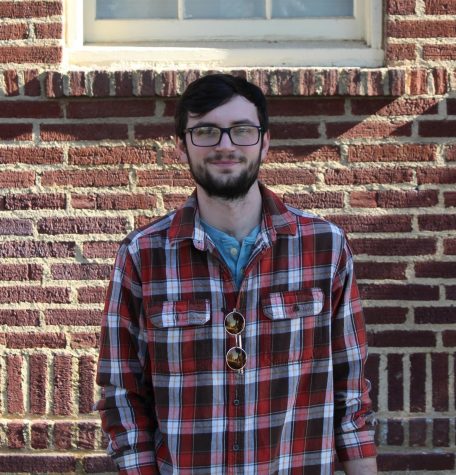
Kris with a K like Kool-aid is a reporter for the Rampage. Kris is a 21-year-old government journalism major who drives a Prius named Cherryl that he parks...
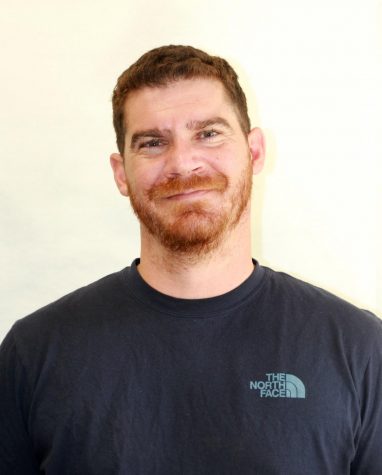
Derek Bullis, 31, is a second semester journalism major taking on the challenges of his new position as opinion editor for the Rampage. He is excited and...
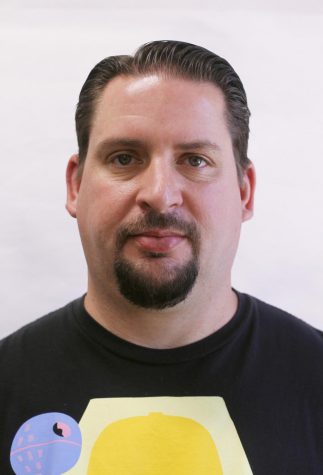
Mark Ross was born and raised in Fresno, California and attended Bullard High School. Mark Ross is currently a student at Fresno City College studying...

